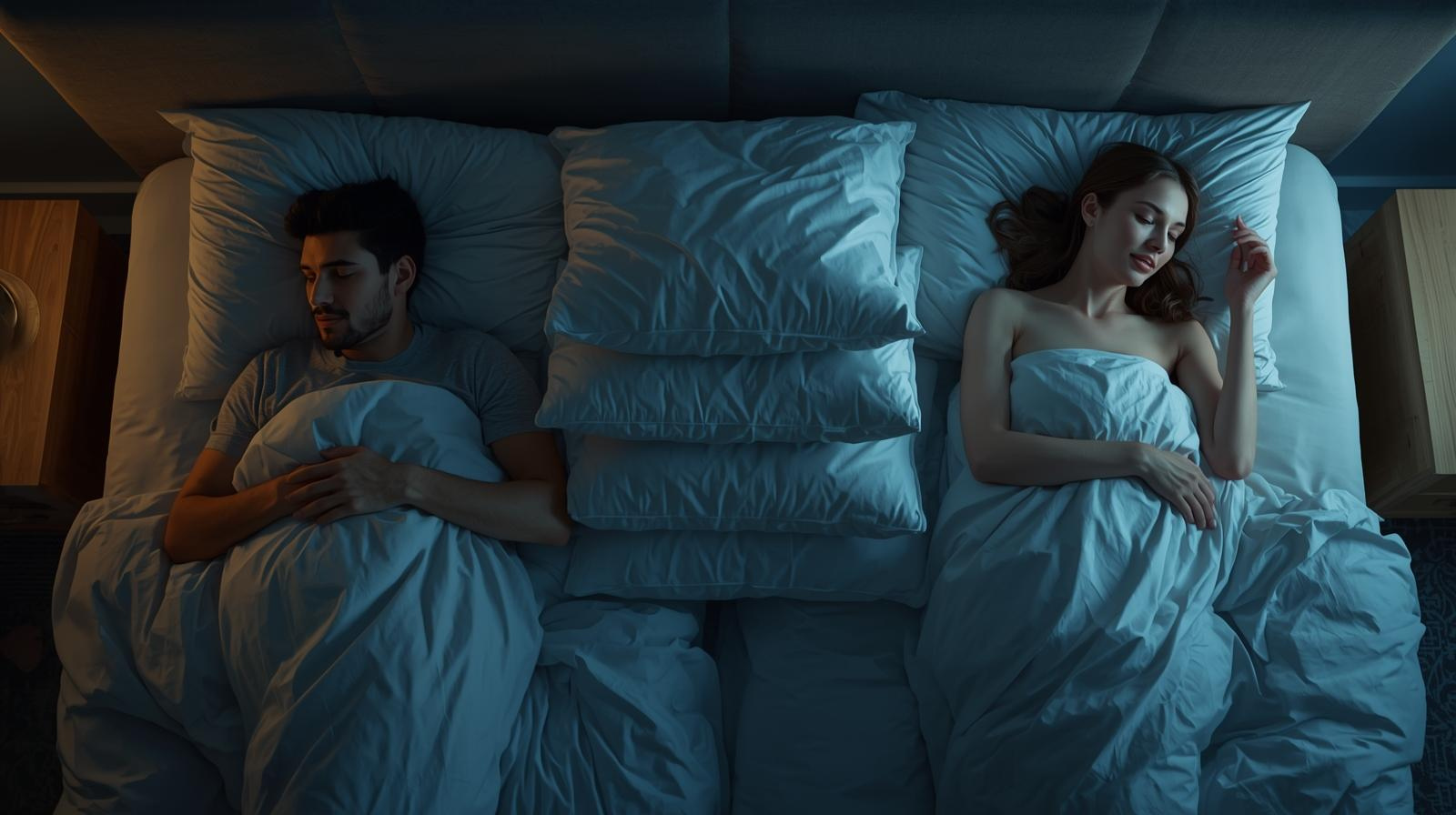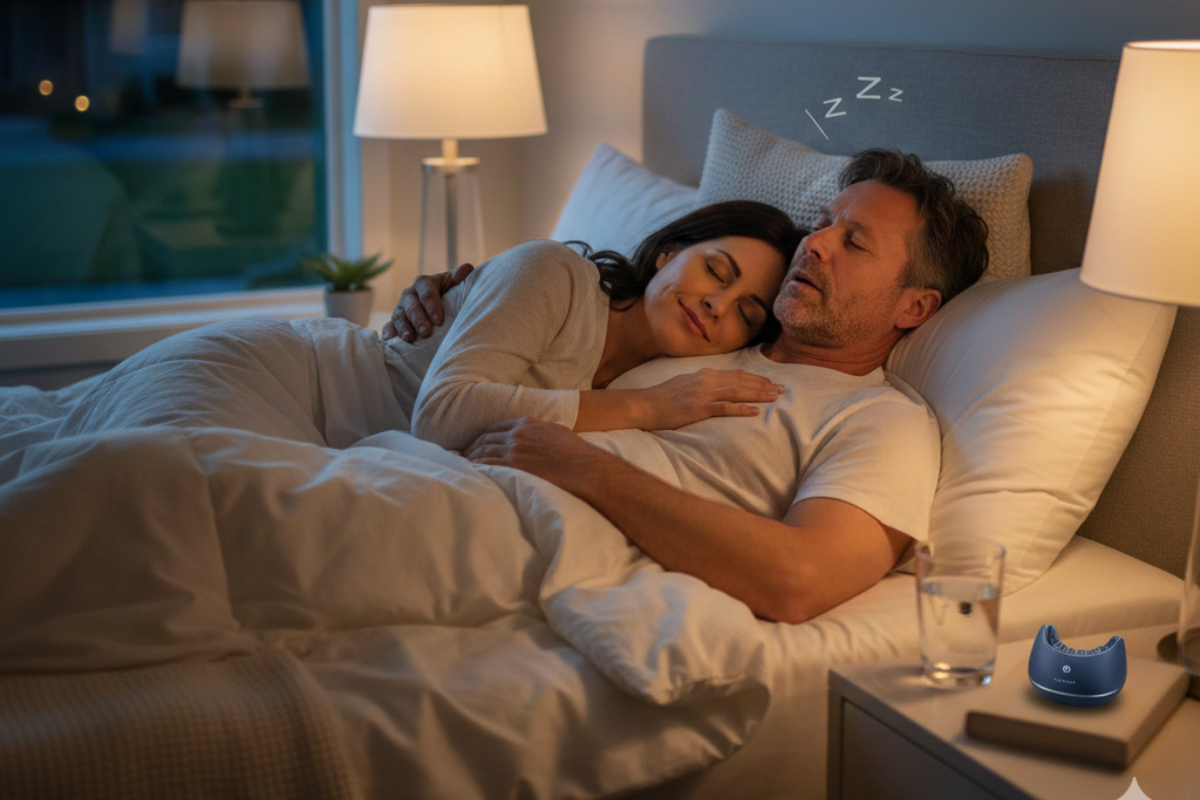Free Shipping - On Orders Over $99 (USA, Canada, UK, & AU)

Snoring in Young Adults: Recognizing the Risk
September 17, 2018 11 min read
Written by: Michael Todd Sapko MD, PhD
What is snoring?
Snoring is the sound produced by vibrations of the mouth and throat (upper airway) during sleep. When we sleep, the muscles in the neck relax, and tissue in the throat (pharynx) collapses a bit, blocking airflow from the nose and mouth. Gravity and relaxed muscle tone also cause the tongue to fall into the airway. These tissues impede the flow of air and, as air passes by, the tissues vibrate, causing the snoring sound that everyone has heard. In essence, upper airway constriction during sleep causes snoring.
Who snores?
Snoring is extremely common. In otherwise healthy people between 30 and 60 years old, 44% of men and 28% of women snore virtually every night. In fact, almost everyone snores occasionally. People of all ages snore, from infants to children to adolescents to middle-aged adults to the elderly. Snoring often begins during adolescence and young adulthood; though snoring may go unnoticed and undiagnosed in this age group if patients sleep alone. This is particularly troubling since the detrimental health effects associated with snoring are cumulative, which means that if they start early and are left untreated, they get worse over time. Therefore, if someone starts to snore as young adult, the problems could magnify by the time they reach middle age.
Is snoring a problem?
Not everyone who snores has a problem. On the other hand, snoring may be a clue to a severe condition such as sleep-disordered breathing or obstructive sleep apnea. Most sleep researchers agree that the severity of snoring exists on a continuum. On one end of the spectrum is simple snoring, and obstructive sleep apnea is on the other end. In the middle are conditions such as sleep-disordered breathing and upper airway resistance syndrome.
While simple snoring does not generally pose an immediate health risk to the patient, it can create substantial problems for the patient's partner. Even simple snoring can be loud, and can prevent the snorer’s partner from getting adequate sleep. In the extreme, snoring has led to physical fights and divorce, according to the Married Couples Sleep Study at Rush University Medical Center.
When trying to determine if snoring is a problem for the patient, physicians generally focus on two things: airflow and sleep quality. If the snorer has reasonably good air flow to and from the lungs, snoring is unlikely to be an immediate health problem. When airflow is more restricted, the patient must work harder to keep the airway open. This means breathing harder, coughing, gasping, and waking at night. If too much of this extra work occurs, it interferes with sleep, leading to daytime tiredness and the many other health effects that come with obstructive sleep apnea.
I hardly snore…do I have a problem?
Unfortunately, the loudness of snoring does not always correlate with airflow. Loud snorers may have reasonably good airflow, while soft snorers may have dangerously low degrees of airflow. Consequently, snorers cannot know if their snoring is a health problem simply by knowing how loudly or softly they snore (especially in younger patients). The only way to know for sure if snoring represents a medical problem is to have a sleep study (i.e. polysomnography).
Snoring is a problem that gets worse over time
Since snoring exists on a spectrum, from innocuous snoring to dangerous snoring, all snorers are at some risk of having problem snoring—if not currently, than in the future. Unfortunately for people who snore, the snoring spectrum is tilted toward increasing danger. Stated another way, simple snoring tends to become mild obstructive sleep apnea and mild obstructive sleep apnea tends to become severe obstructive sleep apnea. This worsening can happen quite quickly. Pendlebury and colleagues found that untreated sleep apnea could get substantially worse in as little as 17 months. While weight gain can be a reason for worsening sleep apnea, the Pendlebury group found that weight was not always a factor, i.e., sleep apnea got worse even in people who maintained the same weight. Moreover, this progression can happen in people of all ages. In a study of 70 children aged 6 to 13 years old diagnosed with primary snoring, 37.1% had progressed to obstructive sleep apnea over a four-year period.
The consequences of problem snoring
Large epidemiologic studies suggest that snoring may be related to high blood pressure, cardiovascular disease (e.g. atherosclerosis, heart attack), and cerebrovascular disease (e.g. stroke). Norton and Dunn showed that in over 2000 people surveyed, snoring was associated with high blood pressure, heart disease, diabetes, and daytime sleepiness, among other problems. The risk of developing these conditions was higher as snorers got older. In a larger epidemiological study (~3000 patients), researchers found that snoring increased the risk of cardiovascular disease and stroke, each by 1.6-fold. Snorers relative risk of ischemic heart disease (narrowing of coronary arteries) was 1.9 times that of non-snorers.18 Gislason and co-authors showed that the risk of high blood pressure and daytime sleepiness in women who snore was similar to that in men who snore—and higher than in people who do not snore.
While the effects of snoring get worse with age, young people are not immune to the health effects of snoring. Snoring appears to hit men under the age of 40 particularly hard. The rate of high blood pressure in snorers under the age of 40 is much higher than in non-snorers of the same age. In other words, problem snoring increases the risk of blood pressure in men, but substantially increases that risk in young men. Young women are at risk as well, even if they are soft snorers (which women tend to be). Dunai and colleagues showed that women of all ages who were quiet snorers were significantly more likely to have high blood pressure and experience a heart attack than non-snorers. Importantly, the more that snoring interfered with breathing in young women, the higher risk of high blood pressure and heart attack.
Why snoring is a problem in young adults
There are five main reasons why snoring is a serious issue for young adults.
- Many young adults do not know they snore, so they go undiagnosed—either they sleep alone or their partners do not tell them that they snore
- Most adolescents and young adults don’t think snoring is a problem for them—even young people who know they snore do not realize the dangers that could result from problem snoring
- Any degree of snoring could be problem snoring—the loudness of the snore does not necessarily indicate its severity
- The health problems associated with snoring get worse with time—young snorers who want to avoid health problems should seek treatment early
- Certain effects of snoring hit young adults hardest—high blood pressure and ischemic heart disease risk are much higher in young snorers than in young non-snorers
What can I do?
The first step is to determine whether you have problem snoring. When physicians try to determine if snoring is problematic, they consider several questions including:
- Who is most affected by the snoring? The patient or the patient’s partner? Both?
- How disruptive is it to life and relationships?
- How long has snoring been a problem?
- Has there been a recent, large increase in body weight?
- Does it just happen after drinking alcohol or taking sedatives?
- Could the problem be related to nasal polyps or trauma to the nose, sinuses, or face?
- Does sleeping disturb sleep? The patient or the patient’s partner? Both?
- Lastly, could the patient have obstructive sleep apnea?
Snoring that happens most nights of the week, even when the snorer does not use alcohol or sedatives, is at least simple snoring. While only a medical professional can diagnose it, problem snoring is snoring that significantly affects you and/or your partner. If snoring is affecting your partner—but not necessarily affecting your breathing or sleep—it can still be a significant issue that demands attention. If the snoring disturbs sleep and leads to daytime sleepiness, it is almost certainly problem snoring. Lastly, coughing, waking at night gasping for air, substantial daytime sleepiness, and stretches of time in which breathing stops could indicate obstructive sleep apnea. If you suspect you have obstructive sleep apnea, talk to a medical professional about it.
If you suspect you have problem snoring, there are several possible treatments. Most people with problem snoring pursue one or more of these treatments.
Weight loss - Snoring is often associated with excess body weight. Conversely, losing weight can help reduce snoring. It is important to note, however, that people of normal weight snore as well, so weight loss is unlikely to be helpful in normal weight snorers.
Tobacco and alcohol cessation – Smoking and alcohol make snoring worse, and tend to make it more dangerous. As such, quitting smoking and not drinking/drinking in moderation may help.
Side-sleeping – Most snoring occurs when the snorer is lying his or her back, and rarely occurs when the person sleeping on his or her side. Posture alarms, special sleep shirts, and side-sleeping pillows help encourage people to sleep on their sides instead of their backs. While this therapy makes sense and can work for some people, the scientific evidence to support them is relatively weak.
Therapies that open the nasal passages – When airflow through the nose is reduced and leads to snoring, nasal decongestants, steroid nasal sprays, and/or nasal dilators may help. This is especially true for people who have seasonal allergies and/or chronic inflammation of the sinuses. While structures in the back of the throat and tongue are responsible for most snoring, improving airflow through the nose can help in some cases. Notably, nasal surgery to treat snoring is rarely effective and is associated with risk.
Oral appliances – Oral appliances held in the mouth during sleep can decrease snoring. The two main types of oral devices are tongue-retaining mouthpieces and mandibular advancement devices. Tongue-retaining devices pull the tongue forward slightly and out of the airway. This is especially useful for patients who sleep on their backs, since gravity pulls the tongue down and into the airway. Mandibular advancement devices, on the other hand, hold the lower jaw forward and keep the throat from partially collapsing during sleep. When used properly, oral anti-snore devices are a highly effective treatment for snoring. The American Academy of Sleep Medicine and American Academy of Dental Sleep Medicine Clinical Practice “recommend that sleep physicians prescribe oral appliances, rather than no therapy, for adult patients who request treatment of primary snoring (without obstructive sleep apnea).”
Continuous positive airway pressure (CPAP) – CPAP significantly reduces snoring by using constant air pressure to keep the airway open. Unfortunately, most insurance companies do not cover the cost of CPAP for snorers who do not also have obstructive sleep apnea. Thus, people without sleep apnea who snore may not be eligible for CPAP device or supply reimbursement, which could run into the thousands of dollars.
Interestingly, patients also tend to prefer oral appliances over CPAP for treating snoring alone. Researchers compared the use of oral appliances versus CPAP (three months each) in people who snored. While both the oral appliance and CPAP device significantly reduced snoring, most patients preferred the oral appliance over CPAP because the oral appliances were more convenient (i.e., the oral appliance included fewer supplies, did not require mask, did not impede movement during sleep, etc.).
Summary
Snoring can be a problem regardless of age. In fact, snoring is a particular problem for young adults under the age of 25 because it tends to go unrecognized and undiagnosed. The health problems associated with snoring tend to increase over time. If left untreated, snoring as a young adult can cause health problems such as high blood pressure and heart disease. Weight loss, smoking cessation, and alcohol reduction are conservative measures that can reduce snoring. Oral appliances such as tongue-retaining devices may be the optimal treatment for snoring because oral appliances effectively reduce snoring and are preferred by patients over other snoring treatments, such as CPAP. Indeed, the American Academy of Sleep Medicine and American Academy of Dental Sleep Medicine Clinical Practice specifically recommends oral appliances, such as snoring mouthpieces, to treat adult patients with primary snoring.
References
- Young T, Palta M, Dempsey J, Skatrud J, Weber S, Badr S. The Occurrence of Sleep-Disordered Breathing among Middle-Aged Adults. N Engl J Med. 1993;328(17):1230-1235. doi:10.1056/nejm199304293281704
- Sateia MJ. International Classification of Sleep Disorders-Third Edition: Highlights and Modifications. Chest. 2014;146(5):1387-1394. doi:10.1378/chest.14-0970
- Piteo AM, Lushington K, Roberts RM, et al. Prevalence of Snoring and Associated Factors in Infancy. Sleep Med. 2011;12(8):787-792. doi:10.1016/j.sleep.2011.01.019
- Nixon GM, Davey M. Sleep Apnoea in the Child. Aust Fam Physician. 2015;44(6):352-355.
- Vlastos I, Athanasopoulos I. Cutting-Edge Technologies for Diagnosis and Monitoring of Snoring in Children. World J Clin Pediatr. 2016;5(1):63-66. doi:10.5409/wjcp.v5.i1.63
- Larkin EK, Rosen CL, Kirchner HL, et al. Variation of C-Reactive Protein Levels in Adolescents: Association with Sleep-Disordered Breathing and Sleep Duration. Circulation. 2005;111(15):1978-1984. doi:10.1161/01.Cir.0000161819.76138.5e
- Kleisiaris CF, Kritsotakis EI, Daniil Z, Tzanakis N, Papaioannou A, Gourgoulianis KI. The Prevalence of Obstructive Sleep Apnea-Hypopnea Syndrome-Related Symptoms and Their Relation to Airflow Limitation in an Elderly Population Receiving Home Care. Int J Chron Obstruct Pulmon Dis. 2014;9:1111-1117. doi:10.2147/copd.S67779
- Marrone O, Bonsignore MR. Acute and Chronic Influences of Obstructive Sleep Apnoea on the Pulmonary Circulation. Monaldi archives for chest disease = Archivio Monaldi per le malattie del torace. 1997;52(3):263-267.
- Chi H-Y, Lin C-S, Hsu M-h, Chan P-c, Hu H-H. Chronic Influences of Obstructive Sleep Apnea on Cerebral Venous Flow. Journal of Ultrasound in Medicine. 2015;34(11):2043-2048. doi:doi:10.7863/ultra.14.12065
- Parati G, Lombardi C, Hedner J, et al. Position Paper on the Management of Patients with Obstructive Sleep Apnea and Hypertension: Joint Recommendations by the European Society of Hypertension, by the European Respiratory Society and by the Members of European Cost (Cooperation in Scientific and Technological Research) Action B26 on Obstructive Sleep Apnea. J Hypertens. 2012;30(4):633-646. doi:10.1097/HJH.0b013e328350e53b
- Deary V, Ellis JG, Wilson JA, Coulter C, Barclay NL. Simple Snoring: Not Quite So Simple after All? Sleep Med Rev. 2014;18(6):453-462. doi:10.1016/j.smrv.2014.04.006
- Kristo DA, Lettieri CJ, Andrada T, Taylor Y, Eliasson AH. Silent Upper Airway Resistance Syndrome: Prevalence in a Mixed Military Population. Chest. 2005;127(5):1654-1657. doi:10.1378/chest.127.5.1654
- Carroll JL, McColley SA, Marcus CL, Curtis S, Loughlin GM. Inability of Clinical History to Distinguish Primary Snoring from Obstructive Sleep Apnea Syndrome in Children. Chest. 1995;108(3):610-618.
- Berger G, Berger R, Oksenberg A. Progression of Snoring and Obstructive Sleep Apnoea: The Role of Increasing Weight and Time. Eur Respir J. 2009;33(2):338-345. doi:10.1183/09031936.00075408
- Pendlebury ST, Pepin JL, Veale D, Levy P. Natural Evolution of Moderate Sleep Apnoea Syndrome: Significant Progression over a Mean of 17 Months. Thorax. 1997;52(10):872-878.
- Li AM, Zhu Y, Au CT, Lee DLY, Ho C, Wing YK. Natural History of Primary Snoring in School-Aged Children: A 4-Year Follow-up Study. Chest. 2013;143(3):729-735. doi:10.1378/chest.12-1224
- Norton PG, Dunn EV. Snoring as a Risk Factor for Disease: An Epidemiological Survey. Br Med J (Clin Res Ed). 1985;291(6496):630-632.
- Koskenvuo M, Kaprio J, Telakivi T, Partinen M, Heikkila K, Sarna S. Snoring as a Risk Factor for Ischaemic Heart Disease and Stroke in Men. Br Med J (Clin Res Ed). 1987;294(6563):16-19.
- Gislason T, Benediktsdottir B, Bjornsson JK, Kjartansson G, Kjeld M, Kristbjarnarson H. Snoring, Hypertension, and the Sleep Apnea Syndrome. An Epidemiologic Survey of Middle-Aged Women. Chest. 1993;103(4):1147-1151.
- Park CG, Shin C. Prevalence and Association of Snoring, Anthropometry and Hypertension in Korea. Blood Pressure. 2005;14(4):210-216. doi:10.1080/08037050510034248
- Dunai A, Keszei AP, Kopp MS, Shapiro CM, Mucsi I, Novak M. Cardiovascular Disease and Health-Care Utilization in Snorers: A Population Survey. Sleep. 2008;31(3):411-416. doi:10.1093/sleep/31.3.411
- Parker RJ, Hardinge M, Jeffries C. Snoring. Bmj. 2005;331(7524):1063. doi:10.1136/bmj.331.7524.1063
- Braver HM, Block AJ, Perri MG. Treatment for Snoring. Combined Weight Loss, Sleeping on Side, and Nasal Spray. Chest. 1995;107(5):1283-1288.
- Franklin KA, Gislason T, Omenaas E, et al. The Influence of Active and Passive Smoking on Habitual Snoring. Am J Respir Crit Care Med. 2004;170(7):799-803. doi:10.1164/rccm.200404-474OC
- Nakano H, Ikeda T, Hayashi M, Ohshima E, Onizuka A. Effects of Body Position on Snoring in Apneic and Nonapneic Snorers. Sleep. 2003;26(2):169-172.
- Virkkula P, Bachour A, Hytonen M, et al. Snoring Is Not Relieved by Nasal Surgery Despite Improvement in Nasal Resistance. Chest. 2006;129(1):81-87. doi:10.1378/chest.129.1.81
- Chan AS, Lee RW, Cistulli PA. Dental Appliance Treatment for Obstructive Sleep Apnea. Chest. 2007;132(2):693-699. doi:10.1378/chest.06-2038
- Cooke ME, Battagel JM. A Thermoplastic Mandibular Advancement Device for the Management of Non-Apnoeic Snoring: A Randomized Controlled Trial. Eur J Orthod. 2006;28(4):327-338. doi:10.1093/ejo/cji122
- Ferguson KA, Cartwright R, Rogers R, Schmidt-Nowara W. Oral Appliances for Snoring and Obstructive Sleep Apnea: A Review. Sleep. 2006;29(2):244-262.
- Marklund M. Long-Term Efficacy of an Oral Appliance in Early Treated Patients with Obstructive Sleep Apnea. Sleep Breath. 2016;20(2):689-694. doi:10.1007/s11325-015-1280-1
- Marty M, Lacaze O, Arreto CD, et al. Snoring and Obstructive Sleep Apnea: Objective Efficacy and Impact of a Chairside Fabricated Mandibular Advancement Device. J Prosthodont. 2017;26(5):381-386. doi:10.1111/jopr.12401
- Lazard DS, Blumen M, Lévy P, et al. The Tongue-Retaining Device: Efficacy and Side Effects in Obstructive Sleep Apnea Syndrome. Journal of Clinical Sleep Medicine : JCSM : Official Publication of the American Academy of Sleep Medicine. 2009;5(5):431-438.
- Ramar K, Dort LC, Katz SG, et al. Clinical Practice Guideline for the Treatment of Obstructive Sleep Apnea and Snoring with Oral Appliance Therapy: An Update for 2015: An American Academy of Sleep Medicine and American Academy of Dental Sleep Medicine Clinical Practice Guideline. Journal of Clinical Sleep Medicine : JCSM : Official Publication of the American Academy of Sleep Medicine. 2015;11(7):773-827. doi:10.5664/jcsm.4858
- Robertson S, Murray M, Young D, Pilley R, Dempster J. A Randomized Crossover Trial of Conservative Snoring Treatments: Mandibular Repositioning Splint and Nasal Cpap. Otolaryngol Head Neck Surg. 2008;138(3):283-288. doi:10.1016/j.otohns.2007.11.004
Also in Blog

Healthy Sleep Goals For 2026
December 22, 2025 6 min read

💨 Are Your Nighttime Breathing Issues Robbing You of Your Health and Your Energy?
December 12, 2025 3 min read
Breathing issues during sleep, collectively known as sleep-disordered breathing, are a major public health concern.

Is Your Snoring a Sign of Something More Serious? Unpacking the Science of Sleep
December 05, 2025 3 min read
When you snore, what's actually happening?
Join our Insiders Club
Every week you will receive specials, discounts, and giveaways.
Categories
- Better Sleep
- depression
- Fitness
- funny animal
- Global Citizenship
- health
- Mental Health
- mouthpiece
- nutrition
- pillow
- Productivity
- relationships
- sleep
- sleep apnea
- sleep deprivation
- Sleep Tech
- snoring
- snoring humor
- snoring jokes
- snoring sounds
- stop snoring
- StopSnoringStartLiving
- technology
- Tongue displacement
- travel
- video
- Young Adult

